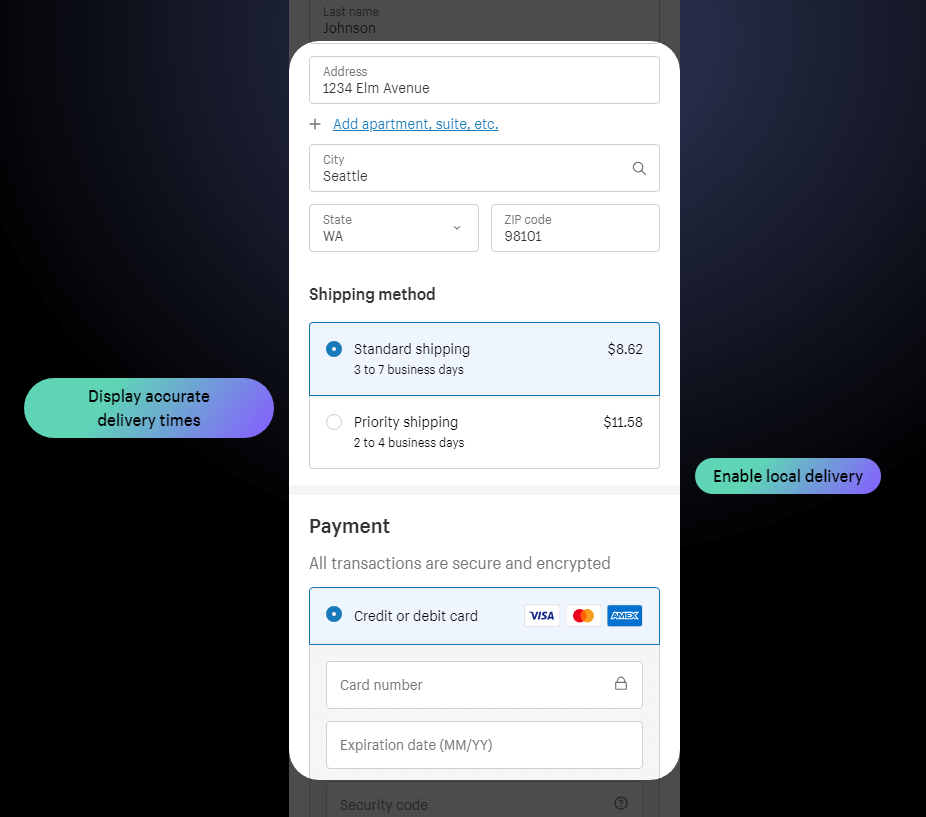Magento and Shopify are some of the biggest e-commerce platforms. Both offer competitive features designed to help brands scale efficiently, but subtle differences can significantly impact how you run your business. Is Shopify better than Magento? Find the correct answer for your business with this guide from Coalition Technologies.

Table of Contents
Shopify and Magento: An Overview
Before we dive deep into the differences between Shopify and Magento, let’s summarize the pros and cons of each.
Shopify: Advantages and Disadvantages
| Advantages | Disadvantages |
| Easy to set up Third-party Shopify Apps are more accessible to integrate vs. Magento extensions. Built-in SEO features User-friendly for newcomers Includes hosting | Limited customization compared to its competitors unless you go headless Pre-built themes can restrict personalization Recurring monthly fees + additional charges for third-party apps |
Magento: Advantages and Disadvantages
| Advantages | Disadvantages |
| Fully open-source and transparent platform Developers can integrate new APIs on the go Extensive support for B2B operations Higher scalability Built-in multilingual support Setting up a store and implementing basic customization does not require coding knowledge. | It only includes hosting if you get Magento Commerce Cloud, which starts at $40,000/year. Requires hiring a developer to make the most of the platform |
Magento vs. Shopify: Main Features
Promotions
Promotions are an essential part of e-commerce marketing strategies. They help convert incoming traffic into customers using coupons, automatic discounts, and offers like buy-one-get-one. 71% of online shoppers are swayed by discount codes – picking the right platform could help you make the most of this powerful conversion tool.
Since both platforms approach promotions differently, it’s difficult to say whether Shopify is better than Magento.
Magento
The Pros: Magento is an open-source platform that allows developers to create diverse and complex promotional scenarios with personalized discounts and tiered pricing. Magento promotions can be divided into two price rules:
- Catalog Price Rules: These discounts are applied to products before they’re added to carts. Stores can create a rule targeting a group of products that share a common characteristic and apply a discount across that group. These promotions can also be scheduled in advance, like for the holiday season.
- Cart Price Rules: These rules apply discounts to products after they’re in the customer’s cart. They can apply discounts based on the cart total and enable buy-one-get-one offers.
Magento promotions are excellent for large enterprises that require a high degree of flexibility for a complex product catalog. Shopify’s promotion features vs. Magento’s are relatively more straightforward and depend on third-party apps.
The Cons: Merchants can create these promotions by going into the Admin panel’s Marketing section, where the complexity begins—Magento promotions work based on condition combinations. Site administrators generate a master condition for the promotion (“If X is True/False”) and add additional rules to that condition to specify which products will be included in the promotion (“Material Contains Cotton”).
This is easy to manage for simple promotions, but things can get quite complex as you add more rules. Magento promotions are easy for developers to implement, but merchants may need help.
Shopify
The Pros: Compared to Magento, Shopify takes a much more user-friendly approach to promotions, albeit at the cost of flexibility. Promotions are built into the Shopify dashboard. Store owners can also choose from an expansive app store featuring thousands of high-quality promotional solutions.
The Cons: Shopify is better than Magento if you prioritize convenience and are okay with likely having to sacrifice some level of customization. You should use Magento’s flexibility if your store or promotions are complex. That said, while Shopify may not be able to achieve all kinds of complex promotions you might want to run, it is possible to do so with an app on the app store (usually paid), or you could custom create your own that uses the Shopify Functions API, which has an ongoing cost of hosting it plus the developer fees to build it. Shopify’s built-in promotional tools and app store solutions should be enough for most businesses.
Checkout
Shopify boasts a conversion rate 15% higher than the competition, and it’s easy to see why.

Shopify
The Pros
- Setup requires no code. The user-friendly dashboard lets merchants set up their checkout pages in minutes, customizing basic appearance settings without tinkering with code.
- Apps that add additional layers of checkout functionality. Merchants can customize payment options based on the user’s geographical location, cart total, and more.
- Shop Pay supports one-click checkout using their saved information, potentially boosting conversion rates by making purchasing easier.
The Cons: The recurring monthly/quarterly subscription fees can add up for Shopify businesses, especially when you start using more paid apps. Using a third-party payment gateway is more expensive because you need to pay the third-party payment gateway transaction fees plus Shopify’s transaction fees.
Additionally, you cannot customize the checkout with apps unless you are on Shopify Plus, and even then, there are some limitations you might face requiring developers to help custom-build or it not being achievable at all.
Magento
The Pros
- Checkout customization is more potent on Magento than Shopify and other e-commerce platforms. Developers can tweak every aspect of the checkout page to suit their needs.
- Magento stores can quickly scale up to serve increasing customers. Merchants can add new payment options and other integrations without waiting for an app or update.
The Verdict: If your goal is to have a higher degree of customization to the checkout with no code, but you’re willing to pay the more expensive Shopify Plus monthly fee, then Shopify is the best suit for you.
Magento is better if you want the most customization freedom and are willing to have developers build your customizations.
B2B
Magento offers a bunch of powerful B2B features right out of the box, including quick ordering, corporate accounts, and quotes. With its granular customization, Magento outperforms Shopify for B2B operations. Businesses can use this enterprise platform to cater to their clients with custom quotes and a corporate account management system that creates a hassle-free purchase process.
Shopify now supports sales reps in the admin. With a few simple clicks, you can designate permissions exclusively for B2B users to access their assigned accounts by allocating roles. Setting up roles with permissions has never been easier, streamlining the process when adding a new representative. These representatives will exclusively view the orders, customers, and companies associated with their respective accounts. This enhancement marks a significant stride for Shopify, which had previously lagged behind competitors like BigCommerce in its B2B offerings. This advancement addresses one of their notable deficiencies.
Developers now have access to the new permissions API to construct applications tailored for B2B purposes. Additionally, there are plans to extend this capability to all merchants, ensuring that regional staff only have visibility into customers within their designated area and that merchandisers solely manage products for the brands under their purview. Once again, Shopify is narrowing critical functionality gaps, benefiting not only B2B merchants but also large-scale enterprise vendors. This feature caters to merchants of varying sizes with intricate sales or management frameworks. Shopify’s ability to seamlessly support merchants with higher complexity has historically posed challenges, making this change a concerted effort to confront that issue.
Content Management
Content management systems (CMSs) help businesses post and manage new content on their websites and also impact the retrieval of other types of information, like product catalogs. Shopify’s intuitive CMS helps businesses post SEO-friendly content by handling many aspects of technical SEO behind the scenes. The platform also handles business hosting, so merchants don’t have to upload their creative assets on their servers.
Magento only provides out-of-the-box hosting for clients if you get Magento Commerce Cloud, which starts at $40,000 per year. However, Magento’s CMS is more competitive than Shopify’s offering for larger businesses, requiring a wide variety of content and heavy documentation. Developers can tweak their Magento stores with a powerful but intuitive page builder to accommodate new types of content and products.
Other Features
As we’ve seen by now, the only honest answer to ‘Is Shopify better than Magento?’ is: it depends! Let’s work through a few other key features to see which platform performs better.
- Customer Groups: Shopify allows users to create customer groups based on specific criteria such as location, purchase history, and order value. This segmentation will enable users to target specific groups of customers with personalized marketing campaigns and promotions. However, Shopify’s customer group functionality is less advanced than Magento’s and may not be suitable for larger e-commerce businesses with more complex customer segmentation needs.

Magento’s customer group functionality vs. Shopify’s is more advanced and allows users to create highly customized groups based on various criteria, including product preferences, shopping behavior, and demographics. This advanced segmentation enables users to create highly targeted marketing campaigns and promotions tailored to specific customer groups. Additionally, Magento’s customer group functionality is highly scalable and can handle large amounts of customer data, making it a better choice for larger e-commerce businesses.
- International: Around 30% of Shopify traffic comes from international visitors. The platform’s ease of use and support for multilingual apps allow merchants to cater to a diverse audience and branch out beyond national borders.
That said, Shopify is similar to Magento in terms of international selling. Magento’s built-in multilingual support eliminates the need for third-party apps or extensions, putting it on equal footing with Shopify. - Merchandising: E-commerce merchandising involves encouraging store visitors to purchase product presentation and personalization. Shopify is equally matched vs. Magento here.
Shopify offers small- and mid-sized businesses some of the most convenient merchandising options on the market. Built-in support for product variants allows shoppers to quickly sort through different versions of the same product without clicking around. For example, an apparel store’s product catalog can display multiple colors for the same shirt.
Other options, like product media, allow merchants to embed videos into their product catalog. Shopify also provides AR functionality for product catalogs.
Magento matches Shopify with a visual merchandiser that allows businesses to customize their product catalogs with minimal coding. Other features like rewards and loyalty programs make creating a personalized shopping experience built around engagement easy. - Magento vs. Shopify Multi-Store Capabilities: Magento allows you to create multiple stores under the same instance, allowing for features like shared product inventory and single connections for integrations (e.g., ERPs). This can bring down the total cost of Magento ownership. On the other hand, Shopify has yet to support this, which could be a deterrent, especially for large enterprise businesses that own multiple brands. Larger companies will find that Magento is generally better than Shopify for multi-store operations.
- Open-Source Code: Shopify is a SaaS platform, whereas Magento has a SaaS offering and an Open-Source option, allowing for more freedom and flexibility. Shopify released Hydrogen a few years ago, which forgoes some of that restrictiveness from its Shopify Native counterpart. However, some restrictions are still based on the plan or the available APIs.
That said, Magento’s open-source nature also opens you up to specific security concerns since the entire code base can be scanned for vulnerabilities to exploit.
Magento vs. Shopify: Making The Right Choice
Magento and Shopify offer a powerful array of features geared for e-commerce in 2024. To make the right decision, consider your budget, the scale of your operation, and the level of customization that your ideal store requires.
Working with a premier digital marketing agency makes choice much more accessible. Our experts can help you build a fully personalized storefront on the platform of your choice. Contact Coalition Technologies for a free consultation today and simplify e-commerce in 2024.
For more info on launching on Shopify, checkout our The Most Comprehensive Shopify Store Setup Guide Ever to kicking off your first store.



